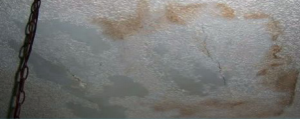That’s So Last Year
IS YOUR BUILDING SUFFERING FROM OUTDATED ‘TRENDS’?
 With the new year comes a new opportunity to be hip — or at least more put together than last year. Commercial buildings don’t often have to worry about being trendy, but there are some outdated problems we see in buildings every day that could easily be addressed. Here are some outdated “trends” you can fix that will improve both the look of your building and its indoor air quality.
With the new year comes a new opportunity to be hip — or at least more put together than last year. Commercial buildings don’t often have to worry about being trendy, but there are some outdated problems we see in buildings every day that could easily be addressed. Here are some outdated “trends” you can fix that will improve both the look of your building and its indoor air quality.
Spotted ceilings aren’t vogue.
Acoustical ceiling tiles are a common sight in commercial buildings. They do a great job of providing a bright, consistent ceiling. However, if they get water stained, then they can also do a great job of making the building occupants uneasy about IAQ.
Water leaks on acoustical ceiling tiles can become quickly obvious, but they can also be beneficial, as even a small leak can be indicative of larger problems in the future. Water leaks should always be addressed quickly by property management. After repairing the leak, it’s important that any water-damaged ceiling tiles be replaced quickly.
It’s not uncommon for ceiling tiles stained with water damaged to raise concerns about mold, even if the water stains are years old. Mold will only grow on acoustical tiles in response to a chronic leak. A short, one-time leak won’t usually support mold. Unfortunately, few people are aware of this fact. If building occupants look up and see stained tiles, they can begin to worry about mold and the air quality inside your building, even if there are no problems.
This year, train your staff to know that replacing ceiling tiles is part of fixing water leaks. This will help eliminate many occupant concerns regarding mold.
Gardens (in your AHU) are out!
When building occupants raise concerns about IAQ, one of our first responses is to check the air handler units (AHU). Failure in an aspect of AHU maintenance can generate problem-causing contaminants. Some of the major components that can create problems are:
Fan Assembly – While the fan housing might be clean, the fan blades hidden inside often aren’t. Dirty blades can be a source of excess particles in the air.
Coil Surfaces – When dust and dirt make it past the filter system, they can become impacted by the coil. Black or slimy discoloration on the surface of the coil is a sign of bacteria, which you don’t want getting kicked into the air.
Drain Pans – If condensate drain pans aren’t draining properly, water can collect and stagnate. If you’ve ever come across a pool of stagnant water outside, you know what this smells like. Pans should be flushed out regularly and equipped with antimicrobial tablets to prevent bacteria from growing.
Internal Insulation – The insulation near the evaporator coil can become a garden of mold. This can happen if water is thrown off the coil and into the insulation.
Regular, thorough maintenance of your AHU can keep these problems from occurring.
IAQ problems will never be “in.” While you can’t prevent all problems, educating building owners and property managers and keeping them up with the times will help them avoid preventable IAQ woes.
